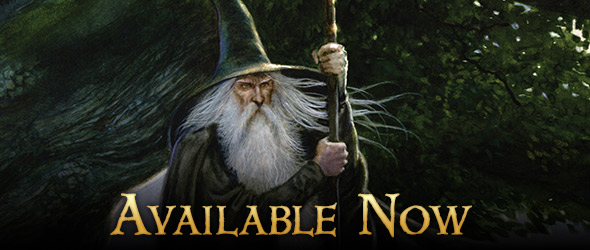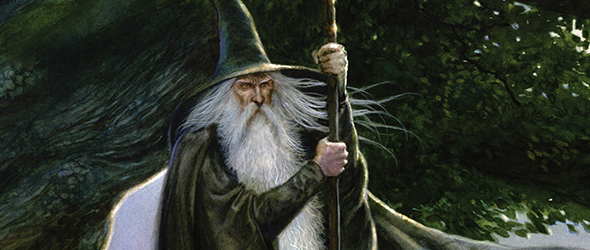
The Lord of the Rings: The Board Game

Sauron’s influence is spreading across the land, corrupting those without the will to stand against him. If he manages to recover the One Ring, the people of Middle-earth are surely doomed—forced to live out their lives in vile servitude. And now the One Ring, along with all hope of salvation, rests in the small hands of a hobbit.
The Lord of the Rings: The Board Game is a unique cooperative board game for two to five players. Legendary designer Reiner Knizia puts players in the roles of hobbits on a perilous quest to destroy the One Ring. Their journey is brought to life by world renowned Tolkien artist John Howe, whose illustrations make this game an immersive work of art. Spanning the entirety of J.R.R. Tolkien’s timeless book trilogy, The Lord of the Rings lets players relive the Fellowship’s heroic journey again and again.
To begin a game of The Lord of the Rings: The Board Game, players first determine which hobbit they will play as—either Frodo, Sam, Merry, Pippin, or Fatty. The number of players determines which hobbits will be available, but Frodo will always be one of the available hobbits. Once hobbits are chosen and the game is set up, it’s time to begin your journey.

Gameplay takes place on the Master Game Board and the four Conflict Game Boards (Moria, Helm’s Deep, Shelob’s Lair, and Mordor). The players’ overall journey is tracked on the Master Game Board, and whenever their Activity marker reaches a Conflict location, the players switch their focus to the appropriate Conflict Game Board. Also located on the Master Game Board is the Corruption Track, which determines how close to darkness the hobbits are treading.
The hobbits begin their quest in Bag End, a Safe Haven. There are three Safe Haven locations on the Master Game Board—Bag End, Rivendell, and Lothlórien. Each Safe Haven has three actions that the players preform before moving on, most of which are beneficial. For example, the first action in Bag End lets each player draw six Quest cards. These Quest cards represent valuable resources that will aid the hobbits in their journey to Mordor.

Quest cards come in two different colors—grey and brown—and a player can only play one grey card and one brown card on their turn. Each Quest card has an Activity symbol on it to represent either Fighting, Friendship, Hiding, Traveling, or a wild symbol that can be used for any Activity type. These cards are used during Conflicts to move the Activity marker along the corresponding Activity tracks.
Conflicts are where the action happens during in The Lord of the Rings: The Board Game. The four Conflict Game Boards consist of several Activity Tracks, one of which serves as the main Activity Track. Each Activity Track is accompanied by an Activity symbol that indicates what types of cards or Story Tiles advance the Activity marker on that track. Players need to move their Activity markers along the main Activity Track to complete the Conflict.

However, it is also important to maintain the other Activity Tracks as well, as they provide useful resources that will come in handy at the end of a Conflict. For example, while playing through the Moria Conflict, the Main Activity track is called “Battle Against the Balrog.” If players only focus on the “Battle Against the Balrog,” they will not be able to collect any Heart or Sun Life tokens as rewards. They will have to play cards on the other Activity Tracks, such as “Quietly Advance Through Moria” and “Flee to the Exit of Moria,” which provide additional Life tokens.
Another feature of the Conflict Game Board is the Event Track, which represents the progressing story of each Conflict. During a Conflict, players take turns drawing from the stack of Story Tiles. Each Story Tile will contain a symbol that either moves the Event marker along the Event Track, moves an Activity marker along one of the Activity Tracks, or activates one of several other actions. During a player’s turn, he will continue to draw Story Tiles until he draws one that moves an Activity marker.
The Event Track is made up of six Event spaces, each one featuring an action that will either force players to discard some of their cards, move further along the Corruption Track, or hinder them in some other way. Conflicts end either when the final Event space is resolved or when the Activity marker on the main Activity Track reaches the end of that track. Since the Event spaces are progressively more deadly, it is in the hobbits’ best interests to end the Conflict before all of the Event spaces are activated.
Each space along the Activity tracks on the Conflict Game Boards provides some sort of benefit to the player that moves the Activity marker into that space. One of these benefits is Life tokens. Life tokens come in three types—Heart, Sun, and Ring. At the end of each Conflict, every player must have one of each type of Life token or risk descending further into darkness. For every type of Life token a player lacks, they advance their hobbit marker one space toward Sauron on the Corruption Track. If ever a hobbit marker meets or passes Sauron’s marker on the Corruption Track, that player is eliminated from the game.
The game ends if the Ring-bearer is ever eliminated, the “The Ring is Mine!” Event is resolved during the Mordor Conflict, or the Fellowship manages to destroy the Ring. The Ring can only be destroyed when the Activity marker reaches the end of the main Activity Track on the Mordor Conflict Game Board. At this time, the Ring-bearer must roll the Threat die and survive its results. If he does survive, the Fellowship manages to destroy the One Ring and saves Middle-earth!

For the game’s anniversary edition, the polished gameplay mechanics and beautiful artwork that shaped previous editions arrives untouched, but you’ll find that the punchboard Hobbit markers, Sauron marker, threat die, and Ring token from the game’s previous edition have been upgraded with brand-new, beautifully sculpted miniatures.
The Hobbits setting out on their journey are shaped with careful attention to detail, from their hairy feet to the top of their sturdy walking stick. The Sauron token has now been replaced with a menacing Black Rider figure, racing forward at a dead gallop and representing the constantly growing threat of corruption. The threat die now represents Sauron’s power in a menacing black. And finally, the One Ring is now a beautiful miniature, graven with Elvish script and perfectly sized to fit over the Ring-bearer’s miniature when they choose to use the One Ring.
Can you stand against the Dark Lord’s influence while carrying the fate of Middle-earth in your hands? Find out with The Lord of the Rings: The Board Game!

60 - 90 Minutes

2 – 5 players

Ages 12+
Products
Awards

Support
Rules
Recent News
The Lord of the Rings and the characters, events, items and places therein are trademarks or registered trademarks of Middle-earth Enterprises, LLC and are used under license by Fantasy Flight Games.





